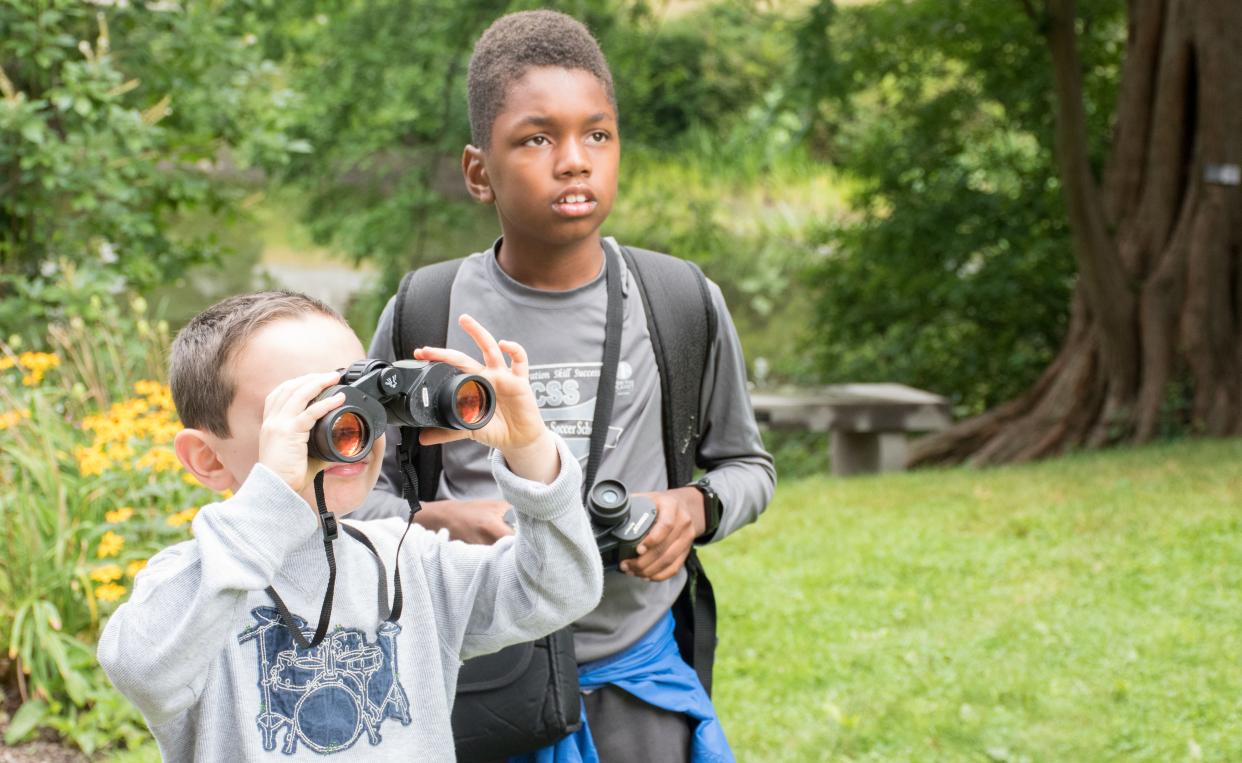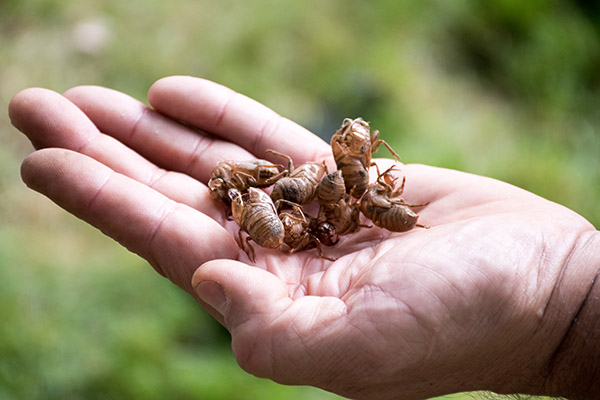Creating a New Model for Citizen Science Education Experiences
Supported by a two-year grant from the A.J. and M.D. Ruggiero Memorial Trust, faculty and students from the College of Liberal Arts and Sciences and Graduate School of Education collaborated with Mount Auburn Cemetery staff to engage visitors in citizen science education experiences focused on wildlife habitat and the environment.
The Mount Auburn Urban Ecosystem project's goal is to create a model of urban nature preservation and engaged citizen science research and education. To date, the project has documented the following outcomes:
- 61,600 contact hours
- 550 participants ranging in age from under 1 year old to 80+
- 5 different programs (1.5–6 hours in duration
The activities that led to the outcomes included:
- Assessing the biological diversity and an assessment of the restoration of wildlife habitats through research on insects (pollinators and ants), bats, birds, and physical features of water and air
- Monitoring the effects of human-environmental interactions through surveys on visitor usage, attitudes, and perceptions
- Integrating the research findings with the Mount Auburn educational materials (pamphlets, mobile-phone applications, public tours, a future smart phone app, and more)
- Engaging the public through self-guided and naturalist-led tours as well as citizen science initiatives
- Contributing to the growing field that examines how nature impacts people

Mount Auburn Cemetery
Mount Auburn is a 175-acre designed landscape in Cambridge, Massachusetts, that serves as both a peaceful oasis for over 250,000 visitors each year and an urban wildlife refuge for a variety of species in the midst of the densely-populated Boston area. It's a National Historic Landmark, accredited Level III arboretum, and Massachusetts Audubon Society Important Bird Area, acclaimed for inspiring the creation of the nation’s public parks.
Associated Undergraduate Courses
The following undergraduate courses may involve Mount Auburn Cemetery visits and work.
-
Course: CBIOL 1101 - Biology with Lab
This course introduces the core concepts in modern biology, with an emphasis on the way of thinking in science. Topics covered include an introduction to organisms and ecology, evolutionary theory, Mendelian genetics, biological chemistry, and biology of the cell. This course meets for four hours weekly in order to integrate laboratory experiences.
-
Course: CBIOL 2101 - Biology II with Lab
In this course, students will build upon the material from Biology I, by examining the underlying processes and emerging properties of living systems, and applying that understanding in laboratory and field work. Topics to be covered include the molecular basis of biological reactions; biology of the cell; plant systems; animal systems; metabolism; reproduction; genetics; evolution; and populations and ecosystems.
-
Course: CBIOL 2505 - Ecology with Lab
This course introduces students to the basic principles of ecological science. Models for population growth, nutrient cycle, food chains, and the extinction and conservation of endangered species are explored in communities of plants and animals. Field trips to local ecosystems (temperate forest, beach intertidal zone, and offshore ocean) enhance students' abilities in observation and analysis and are a major component of the course. Computer simulation is used to illustrate models and principles.
-
Course: CBIOL 1150 FYS - Patterns in Nature
What do lungs have to do with broccoli have to do with rivers? What’s the connection between swarms of bees, rush hour traffic and schools of fish? If your friend’s roommate’s sister is happy, does that affect how happy you are? And does that have anything to do with Internet videos going viral? In this First Year Seminar course, we will explore the connections between various, sometimes seemingly disparate phenomena with key concepts of complexity theory, the core of which is how simple rules give rise to complex phenomena. To start, we will familiarize ourselves with basic topics that we will need to later understand fractals, networks and chaos.
-
Course: CPHYS 1110 - Environmental Science with Lab
This course introduces various aspects of environmental science, including biodiversity, ecosystems, human population, water resources, air pollution, and climate change. Topics will be approached with a focus on urban environments, which will be emphasized through the lab activities and additional readings from journal and news articles. The lab activities will familiarize students with applied environmental science techniques including air and water quality testing, data analysis and visualization, and simple modeling techniques. Field trips will include visits to local watersheds, parks, harbor, and our own campus.
-
Course: CNSCI 3500 - New England Field Studies
This field-based course focuses on the uniqueness of New England's ecology. Students investigate the geology, ecology, and natural history of regional sites including alpine meadow, mountains, and shorelines. The course includes preparation meetings on campus, day trips, and one weekend excursion. Prerequisite: One college science course or permission of the instructor.
Other Ways to Get Involved
Students can work with Lesley faculty and other Mount Auburn Cemetery researchers as part of independent studies or internships. For example, students taking Introduction to Geographic Information Systems (GIS) have gone on to do GIS-based internships and perform other GIS work at Mount Auburn Cemetery.
Students can also focus their capstone research (CNSCI 4550 - Directed Research Capstone: Science) on Mount Auburn Cemetery research projects. Additionally, there are Mount Auburn Cemetery naturalist and citizen science training programs that students can participate in.
Contact Info
- For general information about how to get involved with Mount Auburn Cemetery, please reach out to Dave Morimoto (morimoto@lesley.edu).
- For information regarding pollinator, ant and caterpillar surveys, please reach out to Amy Mertl (amertl@lesley.edu).
- For information about bat research, please reach out to Christopher Richardson (cricha12@lesley.edu).
Studying Urban Ecosystems
Modern ecology, and especially urban ecology, recognizes that both environmental and social factors influence urban ecosystems. Therefore, both factors must be considered in order to understand how to steward urban habitats and guide human interactions with the environment. Mount Auburn was the ideal place for a study of these factors and how they interact, given that its founders envisioned it as a garden burial ground where people could contemplate the cycle of life integrated with a quiet naturalistic wooded place.
"Lesley’s approach to urban ecology is in step with the latest ways to educate people about their local environment,” said Dave Morimoto, director of Lesley’s Natural Sciences and Mathematics department, who is writing a book on human interactions with the natural environment.
"In the past, researchers were focused on cities and pristine environments exclusive of each other," he said, "but now, more researchers are looking at both together. The world population of humans is over 50 percent urban, and over 81 percent urban in the United States. With so much of the world’s population currently living in urban areas, places such as Mount Auburn offer us the opportunity to learn more about how to sustain a healthy ecosystem for both people and wildlife.”
Examples of recent undergraduate study are the use of Geographic Information Systems (GIS) and research comparing vegetation at high and low bat activity sites.
Read more about the Lesley-Mount Auburn collaboration in the Friends of Mount Auburn magazine Sweet Auburn Volume 2 (PDF).
- Amy Mertl
College of Liberal Arts and Sciences - David Morimoto
College of Liberal Arts and Sciences - Jeffrey Perrin
College of Liberal Arts and Science
- Susan Rauchwerk
Graduate School of Education - Chris Richardson
College of Liberal Arts and Sciences - Nicole Weber
College of Liberal Arts and Sciences
